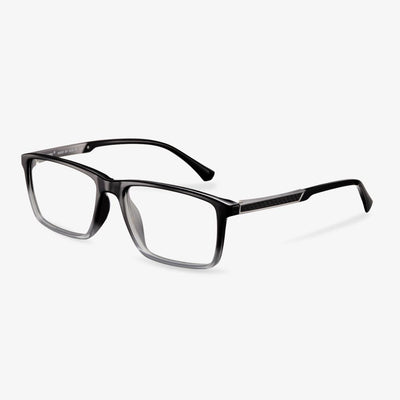Testing of aspheric lens
The optical axis of the optical center just overlaps with the visual axis of the eye, which is the most ideal state. Because the light from the edge cannot form a focus on the optical axis, when the optical axis does not overlap with the visual axis (the difference is greater than 2mm), such unclear and scattered imaging results will occur. When choosing frames and aspheric lenses, you need to ensure that they fit correctly, to achieve the best visual and decorative effects. Simply put, due to the special design of the lens, we found through a calculation that the optical center should move down 1mm higher than the pupil for every 2° increase in front inclination angle. Otherwise, the wrong pupil height will cause the lens to look like astigmatism, and cause discomfort. For glasses with aspheric lenses, there must be an inclination angle after wearing. The specific angle varies from person to person.
What Do Progressive Glasses Mean?
Progressive lenses, also called PALs, are the most popular multifocal lenses today. They offer an effective and great-looking vision solution for individuals with presbyopia. The main benefit of progressive lenses is that they do not have a visible line bisecting the lens, but rather a seamless and gradual change in power as you move down the lens.
Rather than two or three distinct zones, progressive lenses offer a smooth transition of focal powers that covers the total range of clear vision from close to far and every point in between.
Disadvantages of Progressive Lens
There are deformation areas under the left and right sides of the lens, which make the image blurry and irregular. It takes 1-3 weeks to get used to it. In addition, it has a narrower field of view in the near and middle distances, and long-term concentration on the narrow focal point can easily make the eyes tired. Suitable for people who need to alternate between distant, medium, and near vision.
However, with the development of science and technology, more and more progressive multifocal glasses have emerged that have a wider field of view, more comfortable wearing, and better meet the needs of eyes. Nowadays, the use rate of progressive lenses among middle-aged and elderly people abroad is quite high. Single-lens and double-lens reading glasses are gradually being replaced by progressive multifocal glasses.
What is blue light?
Our daily lives are inseparable from mobile phones, computers, tablet computers, and other electronic products. Many people's eyesight is also going downhill due to long-term exposure to strong light electronic screens, and their eyes are more or less potentially adversely affected. It is found that many optical stores sell blue light filter glasses, which have the function of blocking 99.9% UV and scattered blue light, alleviating visual fatigue. They claim that these glasses can block short-wave blue light emitted by electronic products such as mobile phones and computers, and even prevent age-related macular degeneration so they are much sought after by consumers. The price of these so-called anti-blue-light glasses varies greatly, ranging from dozens of dollars to several thousand dollars. Do these blue light blocking glasses really have so many magical functions?
The natural light seen by the human eye is composed of a spectrum of different colors, including red light, orange light, yellow light, green light, blue light, indigo light, purple light, which gives people a visual feeling of white. Different wavelengths present different colors visually, and the shorter the wavelength, the higher the energy. At present, products with electronic screens such as computers and mobile phones use LEDs and other materials to emit light mainly in three colors of red, green, and blue, and blue light accounts for the main part. Blue light belongs to the range of visible light, belongs to short waves. And the wavelength is between 400 nanometers and 500 nanometers, which is close to ultraviolet and carries a large amount of energy. And this part from 400 nanometers to 450 nanometers is called high-energy short-wave blue light.
Visionworks
Eyeglass frames aren't just about sight, they're a fashion statement. In the Visionworks collection of designer glasses, there are top brands to choose from, including Nike, Ray-Ban, and Guess. By using the filter, you can browse the frames by category, gender, brand, price, color, lens type, and more, making it easy to buy glasses online. While the lenses sharpen your vision and bring the world into focus, the frames are a statement of your personality and style. If you want to buy glasses online, they offer a good price option.
What are TR90 glasses?
TR-90 (Plastic Titanium) is a kind of polymer material with memory. It is the most popular ultra-light material in the world at present. It has the characteristics of super toughness, collision resistance and abrasion resistance, low friction coefficient, and can effectively prevent the damage caused to the eyes and face due to the fracture and friction of the frame during the movement.
Why are acetate frames so unique?
The production of acetate frames can be realized in various colors and patterns without painting the frames. The layering of acetate fiber brings varying degrees of transparency and patterns to the spectacle frame. Then this beautiful design makes acetate sheet glasses a more ideal choice than ordinary plastic spectacle frames.











































